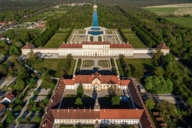
Just a few kilometres north of Munich, you'll find one of Germany's most beautiful examples of Baroque architecture.
Though it may look like a magnificent palace nowadays, the site in fact has very modest origins: Its story began with Wilhelm V., a member of the Wittelsbach dynasty and Duke of Bavaria between 1579 and 1597. During the course of his reign, the Duke found himself in huge financial debt and eventually abdicated in favour of his eldest son Maximilian I.
In around 1598, he commissioned a simple manor house to be built in Schleissheim, an area that, at that point, was still a secluded piece of moorland. His plan was to spend his (many) final years there in a state of contemplation and prayer. Wilhelm’s son had much loftier ambitions and, in 1617, had the entire building torn down right down to the cellar walls and erected the building now known as the Alte Schloss Schleissheim (the Old Palace) in its place.
The late-Renaissance building suffered heavily in the air raids of the Second World War and reconstruction did not start again until 1970. Nowadays, the Alte Schloss houses two collections from the Bayerisches Nationalmuseum (Bavarian National Museum): Gertrud Weinhold’s ecumenical collection “The Religious Year and its Festivals” and an exhibition on culture in Eastern and Western Prussia.
In the early 1700s, Maximilian's ambitious grandson Elector Max Emanuel had his sights set on becoming emperor. So that he could reside in a place worthy of his intended role, he commissioned the construction of the Neues Schloss (New Palace) in 1701, a magnificent baroque building in the middle of the palace grounds. However, the War of the Spanish Succession soon brought an end to his plans. His defeat saw Max Emanuel sent into exile and work on Schleissheim brought to a halt for the time being. By the time he returned to Bavaria, Max Emanuel was forced to scale down his original four-winged and somewhat ostentatious design.
When he died in 1726, only the main building was complete, where visitors to the palace today are able to enjoy the baroque picture gallery belonging to the Bayerische Staatsgemäldesammlungen (Bavarian State Painting Collections).
Earlier, in 1685, Max Emanuel, who was known for his grand tastes, had also commissioned the construction of Schloss Lustheim (Lustheim Palace) in the late baroque style in honour of his marriage to Maria Antonia, daughter of the Austrian emperor. Nowadays, this smaller palace is home to a magnificent collection of Meissen porcelain from the manufacturer’s golden age of the 1700s.
Tip: Take a dander through the park at Schleissheim just like a true royal. The park is one of the best examples of a baroque garden in Europe, with its main features remaining almost completely unaltered.
The project “Bayern 3D - Heimat Digital“ also gives visitors the opportunity to digitally experience important cultural assets as well as the Schlossanlage Schleißheim.
www.schloesser-schleissheim.de
Good to know: Munich Card holders are entitled to a reduced admission fee. If one owns the Munich City Pass, the entrance is free of charge. No matter which card you choose, the public transport is included. Further information can be found here.